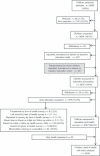Plasmodium falciparum, anaemia and cognitive and educational performance among school children in an area of moderate malaria transmission: baseline results of a cluster randomized trial on the coast of Kenya
- PMID: 22950512
- PMCID: PMC3506732
- DOI: 10.1111/j.1365-3156.2012.02971.x
Plasmodium falciparum, anaemia and cognitive and educational performance among school children in an area of moderate malaria transmission: baseline results of a cluster randomized trial on the coast of Kenya
Abstract
Objectives: Studies have typically investigated health and educational consequences of malaria among school-aged children in areas of high malaria transmission, but few have investigated these issues in moderate transmission settings. This study investigates the patterns of and risks for Plasmodium falciparum and anaemia and their association with cognitive and education outcomes on the Kenyan coast, an area of moderate malaria transmission.
Methods: As part of a cluster randomised trial, a baseline cross-sectional survey assessed the prevalence of and risk factors for P. falciparum infection and anaemia and the associations between health status and measures of cognition and educational achievement. Results are presented for 2400 randomly selected children who were enrolled in the 51 intervention schools.
Results: The overall prevalence of P. falciparum infection and anaemia was 13.0% and 45.5%, respectively. There was marked heterogeneity in the prevalence of P. falciparum infection by school. In multivariable analysis, being male, younger age, not sleeping under a mosquito net and household crowding were adjusted risk factors for P. falciparum infection, whilst P. falciparum infection, being male and indicators of poor nutritional intake were risk factors for anaemia. No association was observed between either P. falciparum or anaemia and performance on tests of sustained attention, cognition, literacy or numeracy.
Conclusion: The results indicate that in this moderate malaria transmission setting, P. falciparum is strongly associated with anaemia, but there is no clear association between health status and education. Intervention studies are underway to investigate whether removing the burden of chronic asymptomatic P. falciparum and related anaemia can improve education outcomes.
© 2012 Blackwell Publishing Ltd.
Figures


Similar articles
-
Impact of intermittent screening and treatment for malaria among school children in Kenya: a cluster randomised trial.PLoS Med. 2014 Jan 28;11(1):e1001594. doi: 10.1371/journal.pmed.1001594. eCollection 2014 Jan. PLoS Med. 2014. PMID: 24492859 Free PMC article. Clinical Trial.
-
Plasmodium falciparum parasitaemia and clinical malaria among school children living in a high transmission setting in western Kenya.Malar J. 2016 Mar 11;15:157. doi: 10.1186/s12936-016-1176-y. Malar J. 2016. PMID: 26969283 Free PMC article.
-
Folic acid supplementation and malaria susceptibility and severity among people taking antifolate antimalarial drugs in endemic areas.Cochrane Database Syst Rev. 2022 Feb 1;2(2022):CD014217. doi: 10.1002/14651858.CD014217. Cochrane Database Syst Rev. 2022. PMID: 36321557 Free PMC article.
-
The High Burden of Malaria in Primary School Children in Southern Malawi.Am J Trop Med Hyg. 2015 Oct;93(4):779-789. doi: 10.4269/ajtmh.14-0618. Epub 2015 Aug 17. Am J Trop Med Hyg. 2015. PMID: 26283750 Free PMC article.
-
House modifications for preventing malaria.Cochrane Database Syst Rev. 2021 Jan 20;1(1):CD013398. doi: 10.1002/14651858.CD013398.pub3. Cochrane Database Syst Rev. 2021. Update in: Cochrane Database Syst Rev. 2022 Oct 6;10:CD013398. doi: 10.1002/14651858.CD013398.pub4. PMID: 33471371 Free PMC article. Updated.
Cited by
-
Efficacy of Nutrition and WASH/Malaria Educational Community-Based Interventions in Reducing Anemia in Preschool Children from Bengo, Angola: Study Protocol of a Randomized Controlled Trial.Int J Environ Res Public Health. 2019 Feb 5;16(3):466. doi: 10.3390/ijerph16030466. Int J Environ Res Public Health. 2019. PMID: 30764549 Free PMC article. Clinical Trial.
-
Infection and co-infection with helminths and Plasmodium among school children in Côte d'Ivoire: results from a National Cross-Sectional Survey.PLoS Negl Trop Dis. 2014 Jun 5;8(6):e2913. doi: 10.1371/journal.pntd.0002913. eCollection 2014 Jun. PLoS Negl Trop Dis. 2014. PMID: 24901333 Free PMC article.
-
Prevalence, Parasite Density and Determinants of Falciparum Malaria Among Febrile Children in Some Peri-Urban Communities in Southwestern Nigeria: A Cross-Sectional Study.Infect Drug Resist. 2021 Aug 18;14:3219-3232. doi: 10.2147/IDR.S312519. eCollection 2021. Infect Drug Resist. 2021. PMID: 34434052 Free PMC article.
-
Current Status of Malaria Control and Elimination in Africa: Epidemiology, Diagnosis, Treatment, Progress and Challenges.J Epidemiol Glob Health. 2024 Sep;14(3):561-579. doi: 10.1007/s44197-024-00228-2. Epub 2024 Apr 24. J Epidemiol Glob Health. 2024. PMID: 38656731 Free PMC article. Review.
-
Severe Malaria and Academic Achievement.Pediatrics. 2023 Apr 1;151(4):e2022058310. doi: 10.1542/peds.2022-058310. Pediatrics. 2023. PMID: 36861307 Free PMC article.
References
-
- Abdalla S, Weatherall DJ, Wickramasinghe SN, Hughes M. The anaemia of P. falciparum malaria. British Journal of Haematology. 1980;46:171–183. - PubMed
-
- Al Serouri AW, Grantham-McGregor SM, Greenwood B, Costello A. Impact of asymptomatic malaria parasitaemia on cognitive function and school achievement of schoolchildren in the Yemen Republic. Parasitology. 2000;121:337–345. - PubMed
-
- Andang’o PE, Osendarp SJ, Ayah R, et al. Efficacy of iron-fortified whole maize flour on iron status of schoolchildren in Kenya: a randomised controlled trial. Lancet. 2007;369:1799–1806. - PubMed
-
- Benoist B, McLean E, Egli I, Cogswell M. Worldwide prevalence of anaemia 1993–2003. In: WHO, editor. WHO Global Database on Anaemia. Geneva: World Health Organisation; 2008. pp. 1–40.
Publication types
MeSH terms
Grants and funding
LinkOut - more resources
Full Text Sources
Medical
Research Materials

